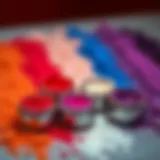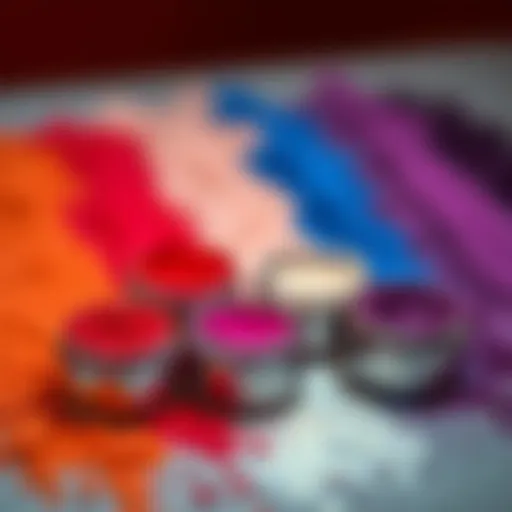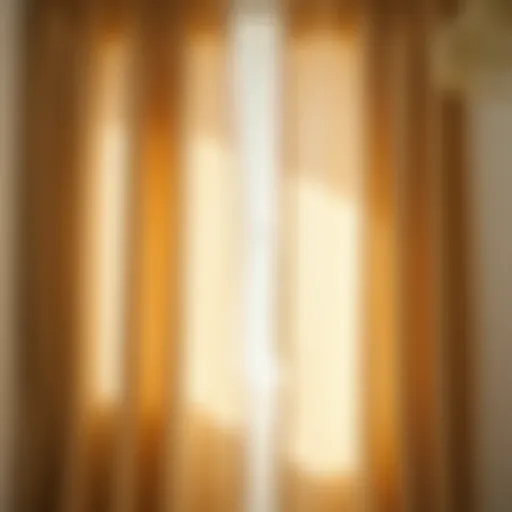Exploring the Versatility of Solid Color Neck Scarves
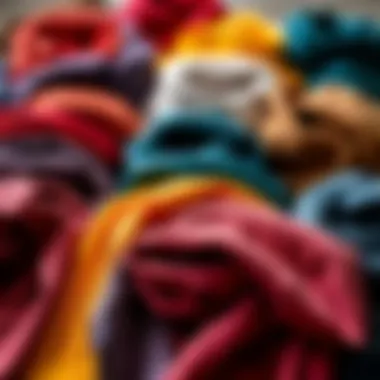

Intro
Solid color neck scarves, often deemed simple yet stylish accessories, have a story that runs deep through the annals of fashion history. These versatile pieces can evoke a sense of elegance or add a pop of color to any outfit. While fashion trends ebb and flow like tides, solid color neck scarves remain a mainstay, adaptable enough to fit into any wardrobe with ease and flair.
Their significance goes beyond mere aesthetics; solid color neck scarves have been worn by various cultures around the globe for centuries. Originally designed for warmth and protection against the elements, they have evolved into a fundamental component of personal style. In this article, we will journey through the rich history, current trends, and clever styling tips associated with solid color neck scarves, proving that they are far from just a simple accessory.
Fashion Trends
Latest Seasonal Trends
As the seasons change, so does the way we wear our scarves. Recently, designers have incorporated bold colors and textures, transforming what was once a straightforward fashion item into a statement piece.
- Bright Colors: Spring and summer are often about vibrant shades, and a bright red or sunflower yellow neck scarf can uplift any outfit.
- Earth Tones: During fall and winter, deeper hues like burgundy, forest green, and navy blue dominate the scene. These earthy tones provide warmth and comfort, reflecting the season's ambiance.
- Textured Fabrics: Lightweight silk or airy chiffon is favored in warmer months, while chunky knit or wool options become essential for colder days.
Iconic Styles Revived
Sometimes, fashion is a game of recycling ideas. Many iconic styles from past decades are finding their way back into modern wardrobes, giving those vintage vibes that many crave today.
- Retro Flares: Think of the 1970s bohemian styles featuring wide leg pants paired with colorful neck scarves delicately tied at the neck.
- The Parisian Touch: The classic French style involves a simple knotted scarf, casually thrown around the neck, often seen on chic Parisians. This effortless look is making waves again, especially with the rise of minimalism in contemporary fashion.
"Fashion should be a form of escapism, and not a form of imprisonment." – Alexander McQueen
Style Tips
Now that we've arrived at the trends, how do we integrate these chic scarves into everyday wardrobe choices? Here are a few style tips to elevate your looks without breaking the bank.
How to Mix and Match
- Layering: Combine your scarf with other accessories like statement earrings or chunky bracelets.
- Color Coordination: Choose a solid color that complements your outfit. For instance, a bright neck scarf can balance a neutral dress, drawing attention upwards without overwhelming the overall look.
Dressing for Different Occasions
- Casual Outings: A loose knot or even a bow can give your ensemble a laid-back vibe suitable for coffee outings or casual get-togethers.
- Formal Events: For more sophisticated settings, consider wrapping the scarf around the neck several times for added elegance or opting for a more streamlined look with a chic knot.
In sanding up to wear a solid color neck scarf is to discover its practical advantages alongside the aesthetic allure. Each choice you make, from color to tying the knot, tells a story of individuality and flair, backed by a rich cultural history and a penchant for the new.
Historical Context of Neck Scarves
Understanding the historical context of neck scarves offers invaluable insight into how they evolved from practical accessories to integral components of fashion. Their significance isn't just rooted in style but also in the myriad ways they have been used over centuries across different cultures. This context highlights the multifaceted roles that neck scarves play, from symbols of status to tools of self-expression. Exploring these dimensions enhances our appreciation for solid color neck scarves, providing deeper knowledge for stylists, designers, and fashion enthusiasts alike.
Evolution Over the Centuries
Neck scarves have traveled through time, shifting in purpose and style with changing societal norms. The concept dates back to ancient civilizations—Roman soldiers donned them as part of their uniforms, not only for warmth but also as distinguishing regalia. Over the years, these accessories layered cultural meanings onto their fabric.
In the 17th century, Louis XIII of France made neck scarves, or cravats, fashionable among the elite. Ladies and gentlemen used them not just to adorn themselves but to convey elegance and refinement. Fast forward to the 20th century; neck scarves found renewed popularity in bohemian circles during the 1960s. Individuals styled them in diverse formats, showcasing their unique identities. The flexible nature of a neck scarf allows it to adapt through eras, embodying the social mores of the time while retaining functionality. Today, they serve as versatile adornments, bridging traditional heritage and modern fashion.
Cultural Significance and Origins
Neck scarves' cultural roots stretch wide, revealing various origins tied closely to local customs and traditions. For instance, in many Middle Eastern countries, scarves serve both as protective garments against the sun and as symbols of cultural identity. The shemaagh or ghutrah is iconic within Arab culture, representing a blend of utility and style.
In East Asia, silk scarves are often tied to elegant dressing traditions. Their rich history is linked to ancient craftsmanship, where artisans imbued each piece with stories and heritage. Each fold and color carries significance, reflecting the wearer’s social standing or personal story.
Moreover, the adoption of solid color neck scarves in the 20th century by various subcultures further illustrates their role as tools of expression. The punk scene, for example, embraced them as symbols of rebellion, while in contrast, they remain fixtures in corporate settings, embodying professionalism.
"Fashion is the armor to survive the reality of everyday life." — Bill Cunningham
Current Trends in Solid Color Neck Scarves
In today's world of fashion, solid color neck scarves are not merely accessories but statements that can define one's style. They have carved out their niche in the wardrobe, serving as versatile pieces that can enhance any outfit. The significance of staying abreast with current trends in solid color neck scarves is crucial for stylists, designers, and marketers alike. Trends often reflect broader cultural shifts, and understanding them can help fashion enthusiasts make more informed choices.
Influence of Fashion Week
Fashion Week is a phenomenon that echoes throughout the fashion industry, serving as a launchpad for trends that set the tone for upcoming seasons. Renowned designers showcase their latest collections, prompting immediate analysis and discussion in the fashion community. Solid color neck scarves often make a splash on runways, serving as vibrant focal points or subtle accents depending on their design. A bold red or deep navy neck scarf, for instance, can transform a minimalist ensemble into a striking statement.
- Spotlight on Variety: Designers utilize a myriad of techniques to express their visions through solid color scarves.
- Cultural Reflections: Fashion Week also serves as a mirror, reflecting societal moods and preferences. This is manifested in the color choices and styles showcased. For example, during periods of economic uncertainty, muted tones often dominate the catwalks, while brighter shades may signify hope and optimism.
- Textural Play: Velvet, silk, and cotton are often used to add depth to these pieces.
- Size Matters: From oversized pieces that resemble capes to skinny options that wrap delicately around the neck, there's a shape for every aesthetic.
The highs and lows of global events can heavily influence scarf designs. The post-pandemic fashion landscape, for instance, has seen a resurgence of cozy, relaxed styles, encouraging the use of neck scarves in soft fabrics that evoke comfort and ease.


Social Media Impact
Social media has revolutionized how fashion trends proliferate. Platforms like Instagram, TikTok, and Pinterest allow users to share their personal style and promote trends almost instantaneously. Solid color neck scarves have found their place in this virtual spotlight, reaching audiences far beyond traditional fashion channels. Their visual appeal makes them Instagram-friendly, often used in styling videos and influencer posts.
- Trendsetters & Influencers: Influencers take to social media to showcase the versatility of solid color neck scarves. They might demonstrate how to style a bold green scarf in various ways—whether it's around the neck, in the hair, or as a handbag accessory. This creative approach has inspired many to explore new styling possibilities.
- Hashtag Culture: The rise of hashtags such as #NeckScarfStyle or #FashionScarf means that users can easily discover how others incorporate these items into their wardrobes. This social engagement not only feeds into consumer behavior but also builds a community around shared fashion values.
"Fashion is the armor to survive the reality of everyday life." - Bill Cunningham
Understanding the impact of social media highlights its role as a powerful tool for the diffusion of new trends, making solid color neck scarves a staple in many wardrobes today. As fashion continues to evolve, staying informed about these trends is essential for those engaged in the industry.
Material Choices for Neck Scarves
Selecting the right material for neck scarves is pivotal, as it influences not only the look but also functionality and comfort. Whether for warmth during chilly months or a stylish accent in a sunny season, material choices can dramatically shape the experience of wearing these accessories. It’s important to consider how different fabrics react to body heat, moisture, and wear over time. When fashion meets practicality, it creates a lasting impression that resonates with style-conscious individuals, be they designers, stylists, or anyone captivated by the nuances of fashion.
Natural Fibers
Natural fibers have an enduring appeal, rooted in tradition and comfort. Fabrics such as cotton, silk, and wool often take center stage in the world of neck scarves. For instance, cotton is renowned for its breathability and softness, making it a prime choice for casual looks or warmer climates. On the other hand, silk provides a luxurious feel and drapes beautifully around the neck, elevating an outfit for formal settings without compromising on comfort. Wool, with its natural insulation, stands out during colder months, embracing the wearer in cozy warmth while keeping the style quotient intact.
One must also note that natural fibers are often more sustainable compared to synthetic counterparts. Fabrics like linen, derived from flax plants, showcase exceptional durability and become softer with each wash. Natural fibers can be a bit finicky regarding maintenance, but with the right care, they promise a richness that synthetic options may lack.
Synthetic Fabrics
In contrast, synthetic fabrics have carved a niche of their own in the realm of neck scarves. The likes of polyester and nylon provide a plethora of advantages, from durability to ease of maintenance. These fabrics resist wrinkling and can often be machine washed without fear of damage. For everyday wear, when versatility is key, synthetic options shine brightly. With their often lower price point and vibrant color retention, they appeal to budget-conscious consumers who still seek flair.
Despite their many benefits, synthetic fabrics can lack the breathability found in natural fibers, which can be a concern for those who prioritize comfort over trend. When discussing fabric choices, knowing how synthetic materials interact with the skin is critical. For example, moisture-wicking options are often favored for active lifestyles, yet some might find that they do not allow the skin to breathe as freely as one might hope.
Sustainable Options
A growing trend among consumers today is the quest for sustainable options that marry style with environmental consciousness. Materials such as Tencel and hemp are emerging as frontrunners in this arena. Tencel, derived from sustainably sourced wood pulp, is incredibly soft and biodegradable, making it a chic yet eco-friendly choice for neck scarves. Likewise, hemp requires minimal water and pesticides to cultivate, rendering it a smart choice for those keen on reducing their carbon footprint without sacrificing their fashion sense.
Moreover, recycled materials have come to the spotlight, allowing fashionistas to sport their scarves guilt-free. Brands focusing on sustainability are not just a passing trend; they represent a shift in consumer expectations, where quality and ecological footprint go hand in hand. This aligns with a growing determination among stylists and marketers to promote products that resonate with conscious consumerism.
"An informed buyer leads to smarter choices, fostering a fashion landscape that respects the earth and elevates individual expression."
In summary, the right material for neck scarves can significantly change the overall experience. Whether leaning towards natural fibers, synthetic fabrics, or sustainable options, the thoughtful selection ensures that wearers can express their style while remaining comfortable and aligned with their value systems.
Design Aspects of Solid Color Neck Scarves
Understanding the design aspects of solid color neck scarves is crucial not just for their aesthetic appeal, but also for their versatility in the fashion repertoire. These elements play a significant role in how these accessories are perceived, utilized, and incorporated into daily wear. From practical considerations to artistic expressions, the designs embody a blend of functionality and creativity that can elevate any outfit.
Shape and Size Variations
When it comes to neck scarves, shape and size can greatly affect how one wears them and influences their overall silhouette. Historically, neck scarves have taken on various forms — from the narrow, slim styles favored in the 60s to the broader, oversized shapes trending today. The choice of shape often ties back to the intended usage. A long, slender scarf can be wrapped multiple times around the neck or draped loosely for an elegant look. Conversely, wider scarves often offer dramatic flair, capable of being worn as a shawl in cooler weather or transformed into a head wrap.
Common shapes and their influences:
- Rectangular: This classic shape is extremely versatile, allowing for myriad knotting styles. It can add an interesting layer to a simple blouse or jacket.
- Square: Often associated with chic, vintage aesthetics, square scarves can be tied in different styles, making them perfect for both casual and formal occasions.
- Infinity Scarves: These are continuous loops, providing an effortless and trendy way to add warmth and style—great for layering.
Size also poses considerations that can impact the overall effect a scarf has. A larger scarf can act as a statement piece, drawing attention, while a smaller one can serve more as a subtle accent. Overall, knowing the right shapes and sizes allows for personal expression and adaptability in styling.
Color Palette Choices
The color palette of solid color neck scarves is more than just a matter of personal taste; it reflects seasonal trends, emotional resonance, and can even influence choices made throughout the day. Color theory plays a significant role in fashion, making it necessary to understand how different shades can evoke specific feelings.
When choosing a solid color scarf, consider the following:
- Neutrals: Colors such as black, white, beige, and gray provide versatility. They can match almost any outfit while maintaining an understated elegance.
- Bold and Vibrant Colors: Bright reds, deep blues, or striking greens can act as the focal point of an ensemble. They invite curiosity and can lift spirits, ultimately affecting the wearer's confidence.
- Pastels: Soft shades like lavender and blush can enhance a more delicate, romantic style. These colors often resonate well during spring and summer.
Additionally, consider the psychological effects of colors:
"Colors can communicate emotions and set moods, making them a powerful tool in personal branding and self-expression."
Styling Solid Color Neck Scarves
When it comes to fashion accessories that pack a punch without taking over an entire outfit, solid color neck scarves are an absolute gem. They're more than just a piece of fabric; they serve as a canvas for self-expression, capable of elevating even the simplest ensembles. In this section, we will delve into the various aspects of styling solid color neck scarves, offering insights on versatile techniques, outfit pairing, and how these scarves seamlessly integrate through different seasons.
Investing time to understand styling techniques can transform a basic look into something stunning. These scarves can serve multiple functions, from providing warmth to adding a touch of flair, making it essential to know how to wear them effectively.
Versatile Styling Techniques
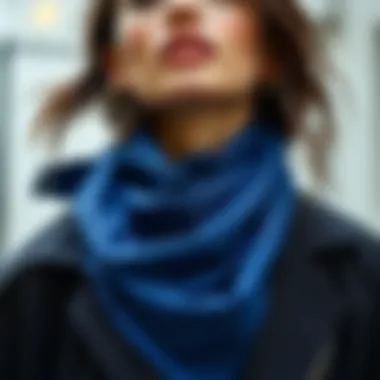

Solid color neck scarves can be styled in countless ways to suit your mood or the occasion. Here are a few popular methods:
- Classic Knot: The most straightforward way, simply tie the scarf around your neck in a knot. This style is elegant and clean, suitable for both casual and formal occasions.
- Belted Look: For a modern twist, thread a scarf through the belt loops of your trousers or skirt, creating a chic belt. This adds color while keeping your outfit grounded.
- Headscarf: Another stylish option is to use the scarf as a headband or hair wrap. It not only looks trendy but also serves practical purposes.
Experimenting with different knots and methods will allow you to discover what feels best for you.
Pairing with Outfits
The art of pairing is where the magic happens. A well-chosen neck scarf can pull an entire outfit together, providing that extra layer of sophistication. Consider the following tips when pairing:
- Contrasting Colors: If you're wearing a muted outfit, opt for a brighter scarf to create a striking contrast. For instance, a bold red scarf can brighten a grey sweater.
- Monochromatic Looks: Layering different shades of the same color can yield a sleek and elegant appearance. Imagine a soft blue shirt complemented by a darker blue neck scarf.
- Textures Matter: Pay attention to texture. A silk scarf can add a luxurious touch to a cotton dress, whereas a wool scarf may work better with heavier winter wear.
Seasonal Fashion Integration
Different seasons call for different approaches to styling neck scarves. A scarf that looks fabulous in summer might not serve the same purpose in winter. Here’s how to adapt:
- Spring and Summer: Light fabric scarves in pastel or vibrant colors can add brightness to your wardrobe. Knot them loosely for a laid-back summer look.
- Autumn: Transitioning to the cooler months means heavier fabrics. Pair richer shades, like deep burgundy or forest green, with a cozy sweater or jacket.
- Winter: In colder weather, wrap a thicker scarf around your neck under a trench coat or over a turtleneck. This serves both as a statement piece and a shield from the chill.
"Fashion is about dressing according to what’s fashionable. Style is more about being yourself."
Understanding how to style solid color neck scarves can enhance your wardrobe while reflecting your personal taste. These scarves are adaptable, making them an accessory worth mastering. Whether you're dressing for an office event or a casual outing, a well-styled neck scarf can be just the ticket to achieving that polished look.
Practical Care for Neck Scarves
Taking proper care of solid color neck scarves enhances their longevity and maintains their aesthetic appeal. Often, people overlook this aspect, assuming that accessories can be treated the same as other clothing items. However, with the investment in a beautiful neck scarf, understanding practical care becomes crucial.
Washing Guidelines
When it comes to washing neck scarves, a little caution goes a long way. Each material has its own set of requirements. For instance:
- Silk Scarves: Hand wash these delicately in cold water using a mild detergent. It is best to avoid twisting or wringing, as this can lead to permanent creases. Instead, lay them flat on a clean towel to air dry.
- Cotton Scarves: These can generally withstand machine washing. Use a gentle cycle with cold water to prevent shrinking. A quick reminder: if they are dyed, washing them separately the first few times may prevent colors from bleeding.
- Synthetic Fabrics: Favorites like polyester or nylon usually prefer a cold machine wash. Check for any recommended settings or specific care instructions on the tag, and dry them flat to keep their shape.
"Washing a scarf is like giving it a drink of water, but too much can drown the beauty."
Each scarf deserves its own careful consideration. The key is to pamper them rather than throw them into the wash with all laundry. This attention not only preserves their beauty but also enhances the fabric feel, ensuring that neck scarves continue to be a delightful addition to any wardrobe.
Storage Recommendations
Proper storage of neck scarves is as vital as washing them. Storing neck scarves correctly can prevent wrinkles, fabric damage, or unwanted fading.
Here are some tips for effective storage:
- Hanging: If you have the space, hanging scarves on a sturdy hanger can prevent creases. Using hangers with clips or even specialized scarf hangers can come in handy.
- Rolling: For those tight on space, rolling scarves instead of folding can save some space and reduce wrinkles. This method can also be more gentle on the fabric.
- Drawer Organization: If using a drawer, consider placing scarves between sheets of tissue paper. This helps maintain their shape and avoid direct contact with other garments that may cause snagging.
- Avoid Sunlight: Store scarves away from direct sunlight to prevent fading. A cool, dry place is ideal.
Maintaining a simple routine of caring for and storing solid color neck scarves can vastly improve their lifespan. By putting forth a little effort in how they are cleaned and where they are kept, one can ensure they remain a treasured item in any fashion enthusiast’s collection.
The Role of Neck Scarves in Personal Branding
In today’s world, where first impressions often leave lasting marks, neck scarves can become an essential asset in personal branding. This accessory is not merely a fashion statement; it serves as a canvas for individuals to express their identity, tastes, and values. Solid color neck scarves, in particular, offer a striking yet subtle way to make a lasting impact.
Personal branding is about showcasing individuality amid the vast sea of sameness. Solid color neck scarves facilitate this by providing a versatile accessory that can be styled in numerous ways. They can convey professionalism in the workplace or communicate artistic flair in creative environments. With the right choice, a neck scarf can express a person’s style without overshadowing their overall look.
Wearing a well-chosen neck scarf doesn’t just enhance a wardrobe; it can also foster connections and communicate messages. A bright red scarf could signify passion and assertiveness, while a soft blue one might suggest calmness and reliability. As such, adopting solid color neck scarves into one’s fashion repertoire can be a strategic move in personal branding.
"Fashion is the armor to survive the reality of everyday life."
Symbol of Individuality
Solid color neck scarves provide an opportunity for much-needed self-expression. They allow individuals to integrate personal style into their outfits, creating a unique signature look. Where one might opt for a vibrant shade, another might choose subtle hues; this choice reflects their personality and preferences. The beauty of solid color lies in its simplicity; it can easily complement a variety of outfits or stand alone as the focal point.
Moreover, wearing a neck scarf in a specific way can showcase one’s creativity and innovation. For example, an unconventional knot or drape could make the scarf appear more than just an accessory; it becomes a part of who the wearer is. This form of expression is particularly important as it often sets a person apart in both social and professional settings. To highlight this, consider:
- Distinctive Colors: Different colors can speak volumes, making it easy for others to perceive wearers in particular ways.
- Unique Styling: How a scarf is tied or draped can add layers of meaning to the outfit.
Thus, in the realm of personal branding, the solid color neck scarf embodies individuality.
Influence in Various Professions
The adaptability of solid color neck scarves affords them a unique place in various professions. In creative fields like fashion design or arts, scarves can be bold expressions of artistic vision. Designers often use colors and styles that challenge norms, utilizing scarves as statements that reflect their personal brand.


On the flip side, in more traditional industries such as finance or law, a solid color neck scarf can add a personal touch while adhering to professional norms. A neutral or muted scarf can enhance a suit, allowing the wearer to stand out without overwhelming their professional appearance. This balance is crucial in roles where composure and reliability must shine through.
In addition, the influences stretch beyond fashion. For professionals who interact frequently with clients or stakeholders, wearing a neck scarf can play a part in establishing rapport. It acts as a conversation starter or a bridge to forge connections. Examples include:
- Corporate Settings: A soft gray scarf blends into a formal outfit, ensuring professionalism while still unique.
- Creative Industries: A vibrant scarf becomes an extension of artistic flair, attracting attention and evoking discussion.
Overall, in the diverse fabric of professional life, solid color neck scarves contribute significantly to personal branding, offering versatility and potential. Thus, adopting such accessories can yield benefits both on a personal and professional level.
Neck Scarves in Global Fashion
The neck scarf serves as more than a mere piece of fabric; it has morphed into an essential element of global fashion, weaving together a tapestry of cultural expressions and personal identity. The burgeoning interest in solid color neck scarves is rooted in their versatility, functionality, and unique charm. As our world becomes increasingly interconnected, fashion statements that were once locality-specific are now embraced and adopted across geographical boundaries. This phenomenon not only highlights adaptability but also showcases a collective appreciation for various styles.
Neck scarves can be bold statements or subtle enhancements, integrating seamlessly with a range of outfits, from casual to formal wear. People now recognize them as key accessories that have the potential to redefine personal style. Moreover, the significance of neck scarves lies in their adaptability, reflecting changing trends but also maintaining their core identity through time.
Cultural Variations
The cultural variations of neck scarves stem from diverse global traditions and historical contexts. In India, for instance, the gamcha is widely used, often serving both practical and symbolic purposes—representing a physical connection to one's heritage. Across Europe, especially in France and Italy, neck scarves are viewed as chic fashion statements, often styled with tailored outfits or casual wear to enhance elegance. Different fabric choices can also reflect cultural identity; silk scarves are often associated with luxury in many cultures, while cotton or linen may symbolize authenticity.
"Every scarf carries a piece of its history, speaking to the hearts of those who wear it."
Moreover, traditional patterns, colors, and adornments differ widely, highlighting the values and artistry specific to each culture. In many societies, neck scarves accompany traditional attire, acting not just as accessories, but as integral components of cultural heritage. Understanding these cultural variations elucidates the sartorial choices people make and the stories they choose to tell through their fashion.
Adoption in Different Cultures
The adoption of neck scarves varies dramatically from one culture to another, yet it showcases a universal appeal that transcends borders. In Japan, for example, the use of a scarf is often associated with geisha fashion, which carries profound meaning and refinement. Here, scarfs aren’t mere accessories; they embody the elegance of tradition while simultaneously appealing to modern tastes.
In contrast, many African cultures demonstrate a rich history of scarf-wearing as a symbol of community and style. Beautifully patterned headscarves, often seen in markets and city streets, celebrate heritage while allowing individual expression.
From high-fashion runways to everyday wardrobes, neck scarves embody a fusion of cultural identity and contemporary aesthetics. As they find new life in various fashion capitals around the world, the neck scarf continues to evolve—a canvas for self-expression, a tribute to tradition, and a bridge across cultures. The exploration of neck scarves in global fashion enriches our understanding of what it means to wear a piece of art, charged with meaning, legacy, and personal significance.
Consumer Insights into Neck Scarves
Understanding consumer behavior around solid color neck scarves is paramount in the broader context of fashion and accessory design. This section sheds light on buying patterns, preferences, and the evolving role of these scarves in various wardrobes. Knowing what drives these choices can inform designers and marketers alike, helping them align their strategies with real-world demands. Moreover, consumer insights can guide potential buyers in making informed decisions when selecting the ideal neck scarf for their style.
Buying Trends
Recent years have seen a noticeable shift in consumer behavior regarding neck scarves. Gone are the days when a scarf was merely a functional item against the cold; today, it serves as a pivotal accessory that can elevate the simplest attire. Solid color neck scarves are particularly popular due to their versatility.
- Personalization: Shoppers increasingly gravitate towards pieces that reflect their unique identity. This leads to a rise in demand for scarves in non-traditional colors or unique textures.
- Influence of Sustainability: Many consumers today care deeply about where their clothes come from and the materials used. Scarves made from organic cotton or recycled fabrics attract eco-conscious buyers.
- Online Shopping Surge: As e-commerce continues to flourish, buying patterns have also changed. Shoppers prefer to purchase scarves online, often influenced by social media trends or style bloggers who showcase ways to wear them.
- Multipurpose Use: An emerging trend is the multi-functional scarf. These can be styled not only as neck accessories but also as hair ties or bags, thus attracting a broader audience.
Market Analysis
The market for neck scarves, particularly solid color options, is surprisingly robust and growing. According to recent insights, the accessories market is projected to expand globally, with neck scarves carving out a significant niche. In analyzing current market conditions, several key elements stand out.
- Demographics: The primary consumers of neck scarves often include women aged between 25-45 years, but there's a notable rise in interest among younger demographics, indicating a potential shift in market focus.
- Price Points: A diverse range of price points exists in the market, catering to both luxury shoppers and more budget-conscious consumers. This balance allows for broader accessibility.
- Retail Channels: Both brick-and-mortar and online retail spaces are vital. However, e-commerce platforms like Amazon or niche fashion retailers like ASOS are increasingly dominating sales due to convenience and variety.
- Competitive Landscape: Notably, brands like Hermès maintain a presence in the luxury segment, while smaller, artisanal brands gain traction by appealing to niche markets with unique, handmade options.
"The evolution of consumer preferences showcases a market dynamic that not only reacts to trends but also sets them. Knowing this can be gold for anyone in the style business."
The Intersection of Art and Scarves
The realm of fashion extends beyond mere fabrics and stitches, often bridging into the vibrant world of art. Herein lies the intersection of art and scarves, a junction rich with creativity and intersecting perspectives. Solid color neck scarves, while practical in nature, become blank canvases that invite artistic expression. This section highlights how the design of scarves transcends utility, transforming into a form of wearable art that resonates with personal identity and cultural significance.
A scarf is often not just an accessory; it’s a statement. The artistry involved in scarf design reflects broader cultural movements and influences. The choices of colors and patterns often carry emotional weight, stirring memories or evoking societal themes. By understanding the artistry of scarf design, stylists, designers, and marketers can gain insightful perspectives on how to best market these garments and connect them with consumers on a deeper level.
Moreover, the incorporation of art into scarf production benefits both creators and consumers. Artists and designers can use scarves as a medium to express their visions, while consumers receive unique pieces that may not just complement an outfit but spark conversation or evoke thought.
"Scarves are like a hug for your neck, and when art intertwines with fashion, it becomes an embrace of self-expression."
Design as Art
When we talk about design, we aren’t merely discussing aesthetics; we’re delving into intention. Solid color neck scarves allow designers to play with concepts like simplicity and elegance while ensuring a canvas that supports various personal interpretations.
Designs can vary greatly even within a solid color palette. For instance, consider a neatly folded silk scarf in crimson. To the untrained eye, it may seem plain, but its sheen can play with light in ways that imbue it with depth. Designers might explore texture, creating subtle differences that surprise the touch and eye. The weight and flow of a scarf fundamentally change how it complements the wearer’s movement, grounding an otherwise basic solid color into something dynamic.
In truth, the successful merging of color and material quality often defines high art in scarves. The texture might evoke emotions—smooth satin suggesting luxury, while a coarse linen might nod to a more rustic feel. This understanding fosters a relationship between the wearer and the art piece.
Collaborations with Artists
Collaborations between established designers and artists have become increasingly common in the fashion world, and neck scarves are no exception. These partnerships lead to collections that elevate the humble scarf into an art form. For instance, a designer might collaborate with a local painter to create a limited edition scarf featuring the painter's abstract designs as vibrant patterns—every piece becomes a limited-edition work of art.
In these collaborations, artists bring their own stories and inspirations to the table. Consumers are purchasing more than a scarf; they are buying a piece of that story, a slice of the artist’s vision. Thus, neck scarves transform into more than fashion accessories, serving as a dialogue between wearer and creator. Not only does this benefit the artists by providing wider exposure, but it can ignite discussions about art in everyday life.
By bridging the realms of art and fashion, these collaborations enrich the market with depth, creativity, and narrative. The impact can be profound, driving sales and increasing engagement among consumers who appreciate artistry intertwined with functionality.
Ultimately, exploring this intersection leads to a richer understanding of both scarves and the world of art—layers of meaning waiting to be discovered, stitched not just into fabric but into the fabric of society itself.






